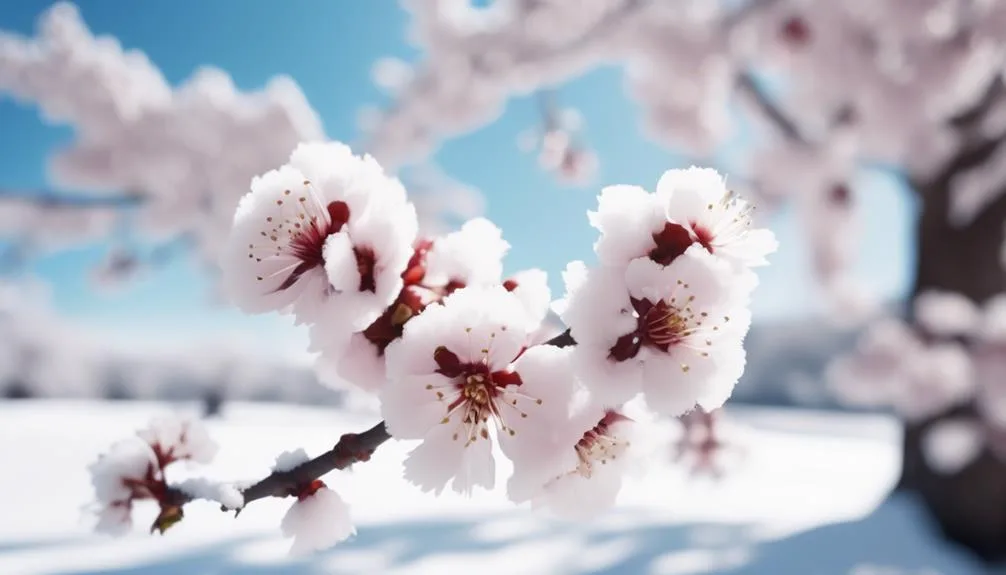Wondering if cherry trees can thrive in cold climates?
Surprisingly, certain cherry tree varieties can flourish in frosty conditions, bringing a touch of sweetness to wintry landscapes.
Imagine plucking juicy cherries from your own backyard in the cold!
Stay tuned to discover the secrets of growing cherry trees in chilly weather and tips for a bountiful harvest.
Suitable Cherry Tree Varieties for Cold Climates
When choosing cherry tree varieties for cold climates, it's crucial to select those that can thrive in harsh winter conditions. Some suitable cherry tree varieties for cold climates include Montmorency, Meteor, and North Star. These varieties are known for their ability to withstand cold temperatures and still produce a bountiful harvest.
When it comes to pollination requirements, some cherry tree varieties are self-pollinating, while others require a companion tree for cross-pollination. It's essential to consider this factor when selecting cherry tree varieties for cold climates.
Additionally, proper soil preparation is vital for the successful growth of cherry trees in cold climates. Ensure that the soil is well-drained, fertile, and slightly acidic to provide an optimal growing environment for cherry trees in cold climates.
Planting and Care Tips for Cherry Trees in Cold Climates
To ensure successful growth and fruit production of cherry trees in cold climates, it's essential to carefully consider the planting location and provide proper care throughout the year.
Start by selecting a well-drained planting site with deep, fertile soil. Prior to planting, prepare the soil by incorporating organic matter such as compost to improve its structure and nutrient content.
Cherry trees require regular watering, especially during dry periods. Develop a consistent watering schedule, providing the trees with deep, thorough watering to encourage deep root growth. However, be cautious not to overwater, as cherry trees are susceptible to root rot.
Additionally, mulching around the base of the tree can help retain soil moisture and regulate temperature.
Protecting Cherry Trees From Frost and Cold Weather
Protect your cherry trees from frost and cold weather by implementing protective measures such as covering the trees with frost cloth or blankets during freezing nights. Winter insulation and frost protection are crucial for the survival of cherry trees in cold climates. Here's how to protect your trees:
- Mulching: Apply a thick layer of mulch around the base of the tree to insulate the roots.
- Watering: Keep the soil around the tree well-watered before the first frost to help insulate the roots.
- Wrapping: Use tree wraps or burlap to shield the trunk from extreme temperature fluctuations.
- Windbreaks: Install windbreaks or barriers to shield the trees from harsh winds.
- Pruning: Trim the trees in late winter to remove any damaged or diseased branches, promoting overall tree health.
Pruning and Maintenance of Cherry Trees in Cold Climates
Consider implementing regular pruning and maintenance practices to ensure the health and vitality of your cherry trees in cold climates.
Pruning during the dormant season, especially in late winter, can help remove dead, diseased, or crossing branches. This promotes better air circulation and sunlight exposure, reducing the risk of disease.
Additionally, winter protection is crucial in cold climates. Wrapping the trunks with tree guards and applying a layer of mulch around the base can shield the trees from harsh temperatures and prevent frost cracks.
Regularly inspect your cherry trees for signs of pests or diseases, and promptly address any issues to prevent them from spreading.
Harvesting and Enjoying Cherries in Cold Climates
Inspect your cherry trees regularly for ripeness, and once the cherries are ready, enjoy the flavorful fruits of your labor in cold climates. Harvesting and enjoying cherries in cold climates can be a rewarding experience. Here are some tips to make the most of your cherry harvest:
- Timing is Key: Pick cherries when they're fully ripe to enjoy their sweet and juicy flavor.
- Gentle Handling: Handle the cherries with care to avoid bruising and damaging the fruit.
- Cherry Tree Pollination: Ensure proper pollination to maximize fruit production in cold climates.
- Pest Management: Keep an eye out for common cherry tree pests in cold climates and take appropriate measures to protect your harvest.
- Storage: Store cherries in a cool place or refrigerate them to maintain their freshness and flavor.
Conclusion
In colder regions, cherry trees can thrive with the right care and cold-hardy varieties, yielding a bountiful harvest of delicious cherries.
With diligent planting, care, and protection from extreme cold, you can enjoy your own homegrown cherries even in chilly climates.
Are you ready to savor the fruits of your labor in colder climates?

My interest in trees started when I first saw the giant sequoias in Yosemite.
I was a teenager then, and I remember thinking, “I need to learn more about this.”
That moment stuck with me.
A few years later, I went on to study forestry at Michigan Tech.
Since graduating, I’ve worked in a mix of hands-on tree care and community education.
I’ve spent over ten years helping people understand how to plant, maintain, and protect the trees in their neighborhoods.
I don’t see trees as just part of the landscape.
They are living things that make a real difference in our daily lives.
